At left, David Markham (left) and Dr. Roberto Guerri, museum director.
These items include the crown and the robe (below) worn by Napoleon. In 1815, all of these items were removed to Vienna, to be stored with similar material relating to the Austrian Emperors. After World War One, Italy retrieved them and they have remained in Milan ever since.
There are many other items of great historical interest in the museum. For example, the collection includes one of the (reputedly) four Imperial Eagles saved from the disastrous retreat in Russia in 1812-1813. Its rescue was credited to General Count Teodoro Lechi (1778-1866), Baron of the Empire and Commandant of the Imperial Guard. The others are at the Musee de l'Armee in Paris. This Eagle belonged to the 2nd Line Regiment.
The collection also includes some excellent snuff boxes, and a wide assortment of documents and prints, many of which are of unique historical importance.
The museum also contains Marshal Massena's sword, possibly given to him after the Egyptian campaign (1798-1799) when he was still a general.
Even Dr. Guerri's office and conference room were filled with First Empire furniture, paintings, miniatures, and other items, including a table and chairs from Napoleon's headquarters.
There are many reasons to visit the beautiful city of Milan. For the Napoleonic scholar or aficianado, the Museo del Risorgimento must rank as the first of these reasons.
Related
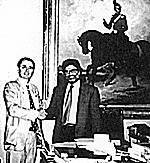 The Museo del Risorgimento in Milan, which is dedicated to the Italian liberation and unification movement, has some of the finest Napoleonic artifacts to be seen anywhere. While this may seem surprising, many Italians consider the actions by Napoleon Bonaparte, first as a general in 1796, and later as First Consul and Emperor, to mark the beginning of the Italian independence movement.
The Museo del Risorgimento in Milan, which is dedicated to the Italian liberation and unification movement, has some of the finest Napoleonic artifacts to be seen anywhere. While this may seem surprising, many Italians consider the actions by Napoleon Bonaparte, first as a general in 1796, and later as First Consul and Emperor, to mark the beginning of the Italian independence movement.
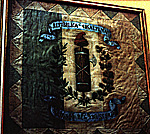 As one might expect, many of the items in the collection relate to Napoleon's time in Italy, and his role as King of Italy. Thus, there are historically priceless items such as one of the first flags of the Cisalpine Republic (at right). The Republic was one of several created by then General Bonaparte in 1796 after conquering northern Italy from Austria. Many scholars regard its formation as one of the significant events in the Italian independence movement.
As one might expect, many of the items in the collection relate to Napoleon's time in Italy, and his role as King of Italy. Thus, there are historically priceless items such as one of the first flags of the Cisalpine Republic (at right). The Republic was one of several created by then General Bonaparte in 1796 after conquering northern Italy from Austria. Many scholars regard its formation as one of the significant events in the Italian independence movement.
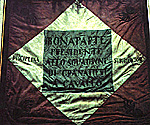 Napoleon was eventually crowned King of Italy in 1805 (shortly after becoming Emperor of France), and the museum has many of the items associated with that coronation. The flag showing Napoleon as president (1802) is at left. The center inscription says: Bonaparte presidente Allo Squadrone Di Granatiert a Cavello" (all in capital letters). The word to the left is "DISCIPLINA" and the word to the right is: "SUBORDINAZIONE."
Napoleon was eventually crowned King of Italy in 1805 (shortly after becoming Emperor of France), and the museum has many of the items associated with that coronation. The flag showing Napoleon as president (1802) is at left. The center inscription says: Bonaparte presidente Allo Squadrone Di Granatiert a Cavello" (all in capital letters). The word to the left is "DISCIPLINA" and the word to the right is: "SUBORDINAZIONE."
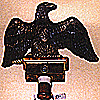 There are several interesting items from Napoleon's first exile at Elba and his brief return in 1815, including an inkwell used by the Emperor on Elba, and an Eagle from the Waterloo campaign (at left).
There are several interesting items from Napoleon's first exile at Elba and his brief return in 1815, including an inkwell used by the Emperor on Elba, and an Eagle from the Waterloo campaign (at left).
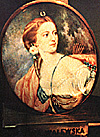 The museum has a significant collection of portrait miniatures, especially of the King of Rome, Napoleon's son. Among the others is a rather fascinating and rare portrait (at left) of Anna Walewska. She was the daughter of the son that Napoleon had with his Polish mistress Maria Walewska.
The museum has a significant collection of portrait miniatures, especially of the King of Rome, Napoleon's son. Among the others is a rather fascinating and rare portrait (at left) of Anna Walewska. She was the daughter of the son that Napoleon had with his Polish mistress Maria Walewska.
 In addition to its role as a major museum, the Museo del Risorgimento serves as a major research archive, and is used by researchers from many nations. The courtyard contains a statue of Napoleon as King of Italy (circa 1810), flanked by guns used in the third war of Italian independence.
In addition to its role as a major museum, the Museo del Risorgimento serves as a major research archive, and is used by researchers from many nations. The courtyard contains a statue of Napoleon as King of Italy (circa 1810), flanked by guns used in the third war of Italian independence.
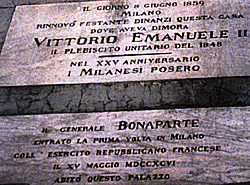 There are several other Napoleonic sites of interest in Milan, including the Plazzo di Brera which is home to an enormous statue of Napoleon by Antonio Canova. The structure, built in the 1780s, now houses a museum, a library and an art school. There is also the building where Napoleon stayed on his first trip to Milan, complete with commemorative plaque (at left).
There are several other Napoleonic sites of interest in Milan, including the Plazzo di Brera which is home to an enormous statue of Napoleon by Antonio Canova. The structure, built in the 1780s, now houses a museum, a library and an art school. There is also the building where Napoleon stayed on his first trip to Milan, complete with commemorative plaque (at left).
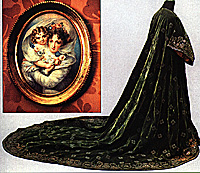 But perhaps the most fascinating of the other sites is also probably the least known. In a house that is part of what could be called the Italian National Trust, there is a collection of furniture, porcelain, and other supurb items, many of them Napoleonic period. Foremost among these items is a collection of twenty miniature portraits, many by Isabey. One of them, an exquisite miniature of Napoleon's second wife Marie Louise and their son the King of Rome (inset at right), is said to have been on Napoleon's bedside table on St. Helena at the time of his death.
But perhaps the most fascinating of the other sites is also probably the least known. In a house that is part of what could be called the Italian National Trust, there is a collection of furniture, porcelain, and other supurb items, many of them Napoleonic period. Foremost among these items is a collection of twenty miniature portraits, many by Isabey. One of them, an exquisite miniature of Napoleon's second wife Marie Louise and their son the King of Rome (inset at right), is said to have been on Napoleon's bedside table on St. Helena at the time of his death.
Back to Table of Contents -- Napoleon #8
Back to Napoleon List of Issues
Back to MagWeb Master Magazine List
© Copyright 1997 by Emperor's Press.
This article appears in MagWeb (Magazine Web) on the Internet World Wide Web.
The full text and graphics from other military history magazines and gaming magazines are available at http://www.magweb.com